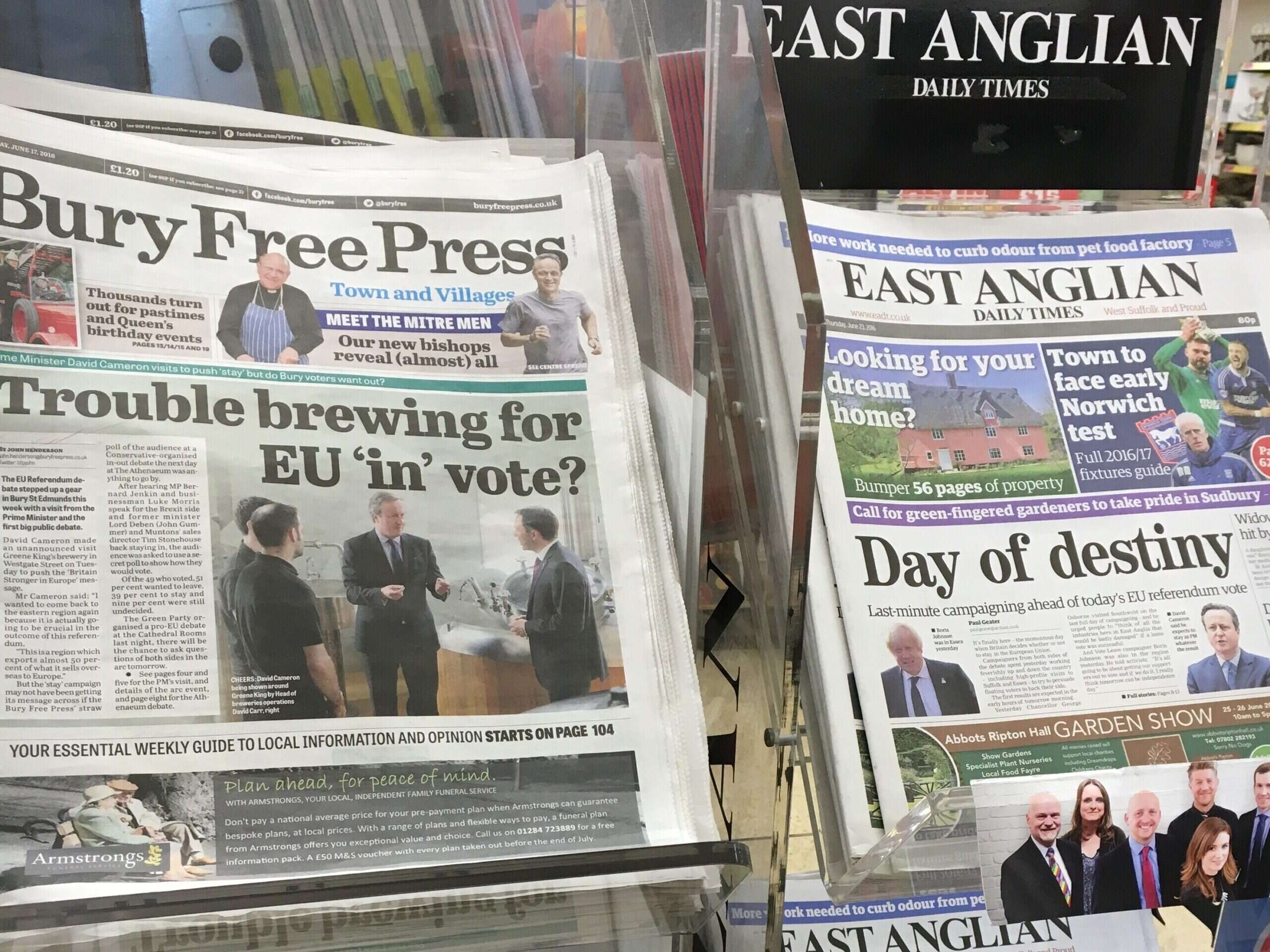
Government -backed research has found that for every percentage point growth in a local daily newspaper’s circulation, electoral turnout on its patch goes up by 0.37 percentage points.
The report, carried out by Plum Consulting for the Department of Digital, Culture, Media and Sport, warned that the decline of the local press reduces scrutiny of democratic functions and that this is “unlikely” to improve without intervention.
It pointed to correlation that shows news provision and consumption has a positive effect on participation in local democracy.
The report was based on research at a local authority level which compared declining turnout in local elections with collapsing local newspaper circulations.
As well as the 0.37 percentage point growth in turnout per 1 percentage point increase in daily newspaper circulation, an additional daily or weekly local title in an area leads to a further 1.27 percentage point increase in voters.
Plum noted that a 1 percentage point growth in daily readership by over-65s saw an increase in turnout of 0.5 percentage points, while 1 percentage point growth in readership in the C2DE demographic (working class and state pensioners) saw a rise of 0.31 percentage points.
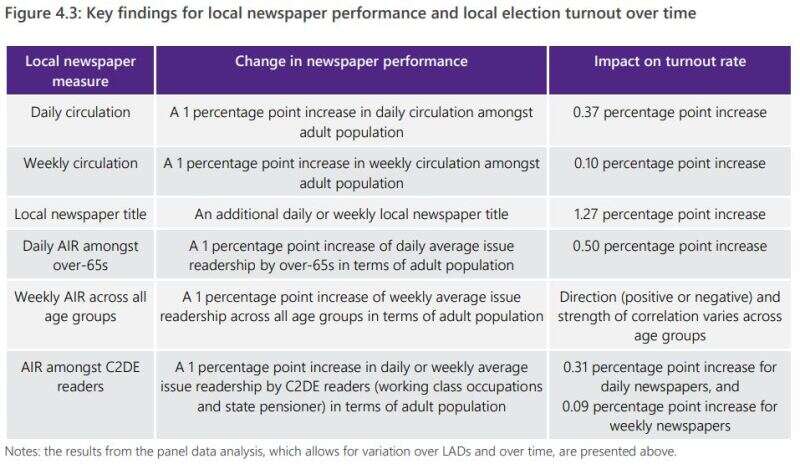
“Further erosion of local newspaper consumption is likely to damage this effect,” the report said.
However the same effect is slim when there is just one weekly newspaper in an area, with a 0.1 percentage point growth in turnout per 1 percentage point of weekly circulation growth.
The report also looked at different types of government interventions aimed at helping the local media.
It called the UK’s approach “fragmented” and said it was hard to assess how effective other countries had been in their attempts as there has been “limited evaluation” of how the money has helped, while the amount given was usually small.
For example, total newspaper subsidies of €32.8m in France in 2017 represented about 1% of industry revenues while newspaper advertising expenditure declined by 5.9% last year according to GroupM estimates.
The report said: “Interventions should be well designed for local journalism and newspapers to provide a key input to civic society and democracy.”
The report will inform the Government’s policy development as it continues to look at what is needed as part of its response to the Cairncross Review into the sustainability of high-quality journalism in the UK.
Media Minister and former Culture Secretary John Whittingdale said: “This government has always recognised the importance of a free press to our country and democracy, but our new research shows just how vital it is.
“The direct correlation between local newspaper provision and electoral turnout proves that a healthy democracy, even at a grassroots level, needs high quality local journalism to thrive.
“In response to the Cairncross Review, we committed to helping put our news media on a stronger footing. Now the pandemic has exacerbated the challenges facing news publishers in what was already a changing landscape.
“With misinformation out there about the virus, the reliability of information is now more important than ever and it remains my absolute priority to ensure we do all we can to support local news outlets during this crisis.
“The long term sustainability of the local and regional press is vital so they can continue holding decision-makers to account.”
UK local newspaper decline in numbers
The report’s analysis of JICREG figures found that average daily print circulation across all local authority districts in the UK was at 31% of 2007 figures in 2019. Weekly print circulation was at 39% of 2007 levels.
Local newspaper circulation decline in the UK 2007 to 2019:
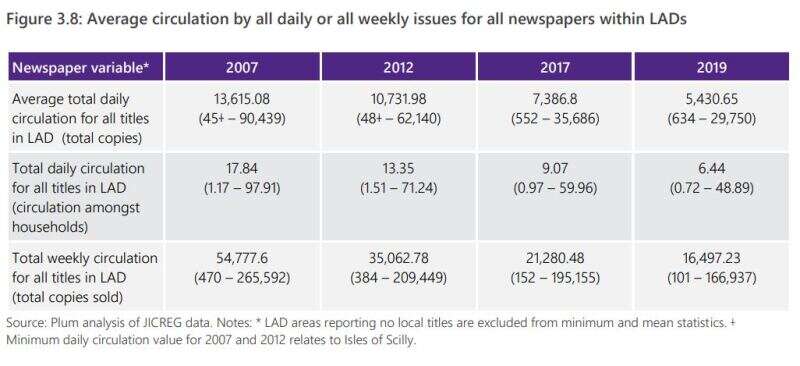
Local newspapers per local authority area 2007 to 2019:  It called the decline of local dailies “substantial”, 380 areas covered by a daily title in 2007 falling to 142 in 2019.
It called the decline of local dailies “substantial”, 380 areas covered by a daily title in 2007 falling to 142 in 2019.
Meanwhile the number of local titles per district in the UK declined from 2.53 to 1.46 in the same 12-year-period.
In addition, 223 districts were served by a single publisher in 2019 and 150 by a single newspaper, of which 47 were dailies and 103 were weeklies.
The report found that the closure of local and regional titles had “led to under reporting and less scrutiny of democratic functions, such as local court reporting and local authorities’ decisions”.
“The resulting strategic responses to commercial decline by the local newspaper industry have been found to have a detrimental effect on titles’ ability to cover local issues, particularly in rural areas.
“Cuts and closures resulting from commercial pressures have reduced scope and capacity and led to the emergence of local monopolies in print journalism across the UK. Research has demonstrated how this translates into negative impacts on public interest journalism.”
In a stark warning, it said: “Scenarios in which there is a reduction of news capacity are likely to be damaging, and the absence of journalism potentially catastrophic.
“The impact on communities by the removal or reduction of local newspaper coverage can be profound.”
Kensington is highlighted in the report as one of 23 local authority areas in the UK with “no local news provision”.
However some of these areas are either covered by hyperlocal and online-only titles that were not included in the data used for the report or by newspapers that did not meet penetration or circulation thresholds.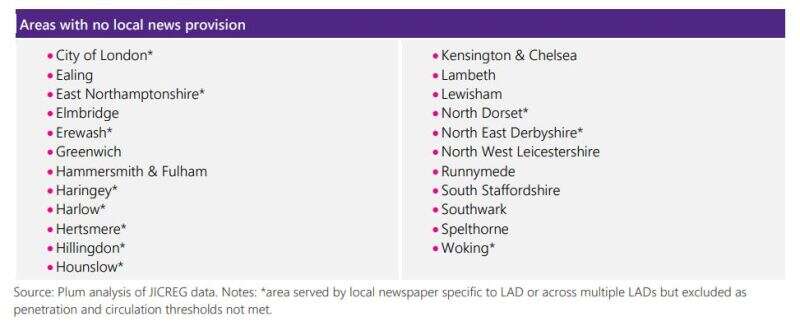
For example, Harlow in Essex is covered by hyperlocal website Your Harlow, the Surrey boroughs of Elmbridge, Runnymede, Spelthorne and Woking are covered by the Surrey Advertiser newspaper, and the London borough of Southwark are served by the weekly Southwark News.
The research for the survey was carried out between March and May and Plum said there was “no doubt” the Covid-19 crisis will exacerbate these trends and have a “significant impact on future market structure, news provision and consumption – particularly for the local newspaper market”.
The report did not assess whether online-only local newspapers or hyperlocal titles were an appropriate substitute for the benefits to democratic scrutiny that print had.
Plum said that although the emergence of hyperlocal news outlets in the UK had been a “positive development”, this has not generally “so far filled the gap in journalistic capacity left by the demise of local newspapers”.
Interventions
The report studied a number of actions taken by other countries to support their newspaper industries.
Regular financial support in Austria was met with relief by its news media, but the report noted the allocation of blanket subsidies “prevents full evaluation as to the extent which the industry subsidy simply underwrites part of newspapers’ revenue… and becomes a normal and predictable portion of industry revenues”.
In Canada, a journalism labour tax credit acts as a subsidy for news production jobs. The report noted that “while there may be a lack of clarity about whether the tax credit will allow for more sustainable newsrooms or simply subsidise a loss-making model, the production of journalism requires personnel and expertise.
“The prevention of further losses to the number of journalists across the country is a clear benefit,” it said.
Meanwhile France has a “vast and complex” system of aid for the press making it hard to unravel the effects, but the report noted that “tiny grants” allocated to smaller weekly newspapers under the direct aid to support pluralism in the market “do not seem to resolve any aspects of the economic pressures facing local journalism”.
The report suggested that the UK market now needs a “more reasoned” public interest approach to its interventions, after a series of “fragmented” public and private measures.
And it highlighted the sharp decline in newspaper newspaper revenue (national and regional) since 2007:
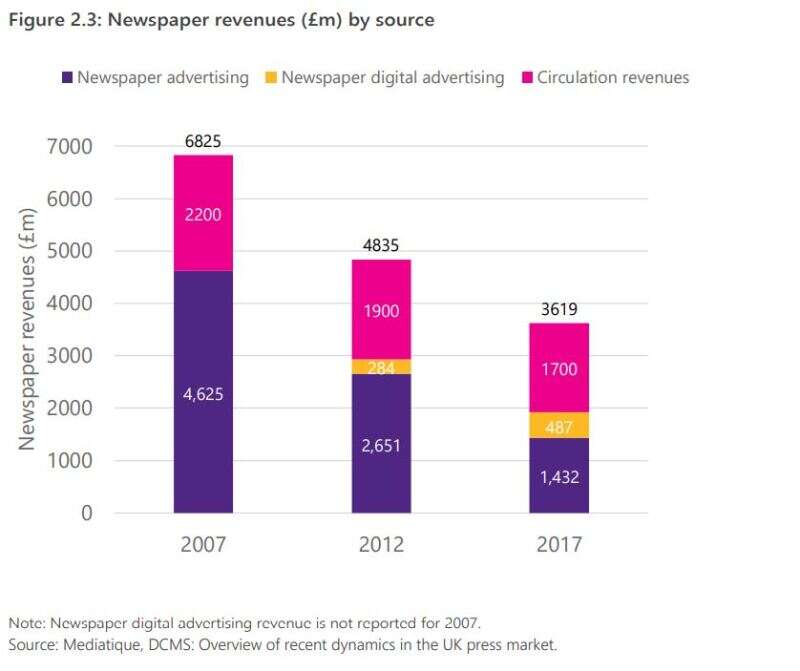
The DCMS said it has already distributed £35m for public health information advertising across 600 UK local, regional and national print titles since the start of the coronavirus pandemic – of which more than 60% (£21m) went on locals and regionals.
It also fast-tracked the removal of VAT from digital publications, has extended a business rates discount on office space to 2025 and is looking at what else to take forward from the Cairncross Review.
“The government will continue to explore additional measures to help the sector,” the DCMS said this week.
More serious than this has been the hollowing out of surviving titles with thousands of journalism jobs gone.
Picture: Dominic Lipinski/PA Wire
Email pged@pressgazette.co.uk to point out mistakes, provide story tips or send in a letter for publication on our "Letters Page" blog
